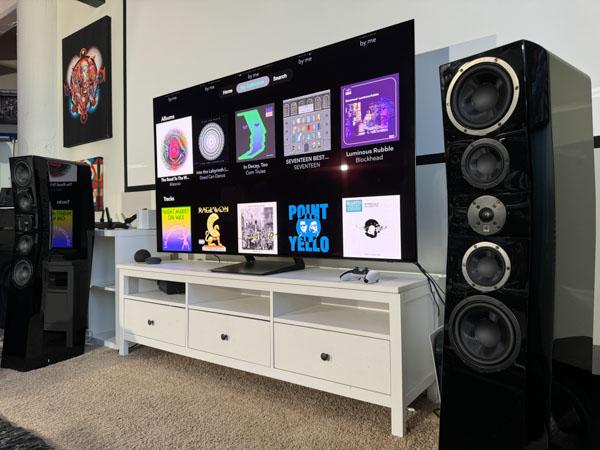¡Saludos, jugadores de casino! Si les gustan los juegos de casino en línea, no pueden dejar de probar Melbet casino online. Esta plataforma ofrece una selección impresionante de juegos, desde tragaperras hasta juegos de mesa clásicos, todo en un entorno seguro y divertido. Además, los gráficos y la experiencia de usuario son de alta calidad, lo que hace que cada sesión sea emocionante. ¡Es el lugar perfecto para quienes buscan entretenimiento y grandes premios!
SVS Ultra Evolution Titan Surround Loudspeaker System Review

AT A GLANCE
Plus
Dynamic, powerful sound
Tight, well-defined bass
Crisp detail
Minus
Best with subwoofers
THE VERDICT
SVS has earned a formidable reputation for producing loudspeakers and subwoofers that outperform their reasonable price points. With the new Ultra Evolution range, they’ve more than upheld their past record. While the Ultra Evolution speakers are the company’s priciest offerings to date, most home theater enthusiasts don’t need to win the lottery or take out a second mortgage to at least consider them.
It doesn’t seem all that long ago that SVS first entered the audio scene. But time does fly. Ron Stimpson and Tom Vodhanel actually launched the company in 1998 in Youngstown, Ohio. The second S in SVS stands for subwoofers, or at least it once did. SVS earned its early reputation by offering excellent but nonetheless affordable subwoofers. Along the way, the company branched out into a range of widely-praised, full-range loudspeakers, plus accessories such as cables. All SVS’s loudspeakers and subwoofers are designed in the U.S.A. and manufactured in China.
While many of SVS’ previous full-range loudspeaker models are still available, the company has now branched out with a more upmarket lineup, dubbed Ultra Evolution (not to be confused with their Ultra models, which lack the Evolution imprimatur). But the company remains dedicated to resisting the insanely-priced trends that have captured much of the high-end audio business. The new SVS Ultra Evolution range tops out with the floor-standing Ultra Evolution Pinnacles at $5,000/pair. That’s hardly pocket change, but compared to much of its high-end competition, it’s within reach for many dedicated audio enthusiasts.
Two additional, lower-priced Ultra Evolution models are also available. These include the Titan at $4,000/pair and the Tower at $3,000/pair. Using “Tower” as the name for one of the models can be a little confusing, in that all three of the floor-standers are towers!
All three of these tower models offer similar design and technology (more on that a bit later) but in progressively smaller (but still floor-standing) configurations. The Titan and Tower are technically similar to the Pinnacle in design, though the latter’s larger bass drivers and cabinet should offer the most bottom-end crunch. On the rear of all the Ultra Evolution tower models are two additional woofers (not subwoofers but rather identical woofers to those in front), plus a pair of 2.5-inch wide, flared ports tuned to optimize the combined four woofers. The woofers on the Pinnacle are larger than those on the other two towers (8-inches for the Pinnacle vs. 6.5-inches for the Tower and Titan). But if you already own, or plan to add, a good subwoofer or two, that should more than make up for any differences in the bass department on the smaller towers. (The Pinnacles will likely sell primarily to 2-channel-only audiophiles, many of whom eschew subwoofers).
As I already had several fully capable SVS subwoofers on hand, I had originally requested a pair of the “small” Ultra Evolution towers, the Towers (sorry, I couldn’t resist; there’s an audiophile “Who’s on first” in there somewhere!). But since the Towers weren’t yet available (they should be by the time you read this), the review here is anchored by a pair of Titans towers.
.jpeg)
In addition to the Titans, the other new Ultra Evolution loudspeakers used in this review were the Center at $800 (kudos to SVS for making this a serious, 3-way design) and a pair of Ultra Evolution bookshef speakers ($1200/pair). A pair of SVS PB-3000 subwoofers were also used in the system (where noted). The one remaining and smallest model in the Ultra Evolution line, the Ultra Evolution Nanos, were not used here. These smaller entries in the Ultra Evolution range incorporate most of the features found in the towers to be discussed here: similarly featured drivers, ported cabinets, optional finishes, removable grilles, and the time alignment to be discussed below, though the latter in more simplified forms that won’t be addressed in detail here.
More Tech
The most visually obvious and intriguing aspect of the three SVS Ultra Evolution floor-standing designs is the configuration of their seven active drivers. Five of these are located on the front—two woofers, two midranges, and a single tweeter. The tweeter is centered on the baffle and positioned roughly at a typical seated ear height. The two midranges are located above and below the tweeter, and the two front woofers are positioned above and below the midranges.
.jpeg)
That alone isn’t unusual for an ambitious loudspeaker design, but what’s rarer is that the front face of the cabinet, where these drivers are located, is curved slightly inward. The point of this configuration is to ensure (as much as possible) that the output of the five front drivers arrives at the listener’s ears simultaneously. There might well be acoustic benefits to this, though for the best results the height of the tweeter, at the center of the front baffle’s driver arrays, should theoretically be at the same height as a seated listener’s ears. In my normal seating position, however, my ears were already several inches higher than the Titan’s centered tweeter. But when I scooched down as low as possible in my listening seat, I heard no obvious audible changes. Nevertheless, I don’t recommend taking a serious audition of the Titans while standing up—which could well be said of more conventional loudspeakers.
.jpeg)
The Ultra Evolution’s midranges and woofers employ glass-fiber cones for maximum stiffness. The tweeter’s diaphragm is aluminum, coated with a layer of diamond carbon for added stiffness. The tweeter also employs a sophisticated diffuser to optimize off-axis performance, dubbed FEA-Optimized Organic Cell Lattice in SVS’s immortal words.
Each loudspeaker in the Ultra Evolution range has two pairs of gold-plated, 5-way terminal posts (apart from a single pair on the Nano). The floor-standers come with soft feet and spikes (I used the soft feet). Magnetically fixed but removable, acoustically transparent grilles are included on all models (they were removed for this review). All of the Ultra Evolution models are available in piano gloss black, piano gloss white, or a black Oak veneer.
Setup
I positioned the Ultra Evolution Titans 8 feet apart near the front of the room, roughly 2 feet out from the wall behind them (measured from the back of the Titans’ cabinet), and angled in toward the center listening seat. The closest sidewall was about 3 feet from the left speaker. The Ultra Evolution bookshelf speakers, used here as surrounds, were positioned high up near the back of the room (my room can’t accommodate Dolby’s recommended positioning—on the sides of the room, just behind the listening position and slightly above ear height). The Ultra Evolution Center was placed on a low stand that angles it slightly upward. The setup also included two SVS PB-3000 subwoofers crossed over at 90Hz and used where noted.
My listening room and setup produce a (measurable and audible) peak between 100 and 200Hz at the main listening seat. This has been the case with virtually every loudspeaker I’ve reviewed in this room, though the precise nature of that peak does vary a bit from speaker to speaker. Rearranging the room is not an option. The only available cure for this (to make it possible to hear the Titans as they’d likely sound in a room without this issue) is room EQ. As I’ve done in the past, I therefore dialed in Audyssey room correction (only below 500Hz) via the Denon AVR-X6700H receiver used in this review. All observations here involve this EQ.
.jpeg)
All the program material used here, both music and movies, was sourced from CDs for music and Blu-ray and 4K Blu-ray for audio/video. Streamed content was not used. An Oppo UDP-203 Ultra HD Blu-ray player was used as the source for both music and movies.
Music
On a wide range of 2-channel music, without the subwoofers (but with Audyssey engaged below 500Hz as noted above), the bass was initially lean. The subwoofers could compensate for this, but I wanted to see how the Titans performed on their own, at least with music. But my room, together with the other spaces to which it opens, is a very large space. In a smaller room, that leanness shouldn’t be an issue. But I managed to overcome it here, to a degree, by bumping up the Denon AVR’s bass control by +2dB. This had no apparent effect above the range that needed help (though keep in mind that tone controls aren’t standardized and their action can vary with different AV receivers). I could have increased the bass control even further, but didn’t want to push each of the Titan’s four 6.5-inch woofers into possible difficulties. They’re designed to resist overdriving to a degree, but boosting the bass on any loudspeaker in a large room must be done with care.
Following that tweak, I listened to a wide range of my usual go-to CD recordings. Years ago, I compiled a list of bass-challenging tracks ranging from Japanese Taiko drummers to pipe organs. Played back at challenging (but not outrageous) levels, the SVS Towers handled everything convincingly. On two occasions, I did notice a fleeting trace of possible overload from the right Titan tower, but could never pin it down. I resisted the urge to turn up the volume even higher to see if I could induce it again, but thought better of this (having no desire to risk possible damage midway through a review!). The barely noticed complaint could also have originated from the Denon AVR (though its 140 watts per channel into 8 ohms has always been more than adequate).
With that one exception, the Titans, driven full range, were extremely satisfying. As powerful as with subwoofers? No, but surprisingly extended for subwoofer-free operation. The weight in the deep bass without subs (in my room) was relatively tame by bass-head standards but was tight and totally free of boom or bloat. Taiko drums displayed their force and weight. Pipe organs were believable. And while neither will erase the memory of two large SVS subwoofers toiling away (an observation about which, I imagine, even SVS’ subwoofer division would agree, at least in private!). For many users, in an average-sized room, complaints about the quality and quantity of the Titans’ bass would likely be rare.
.jpeg)
Higher up in the audio range, there was plenty of detail, with solid imaging and a believable sense of depth. But I was occasionally bothered by a little edginess in the low treble. At modest listening levels, this was seldom an issue, but as the source playback level increased, the upper end of the soprano voice (for example, Loreena McKennitt’s superb vocals in Nights from the Alhambra, one of my all-time favorites) bit back a bit too much. This edginess might be a shortcoming of the source material, which can be more noticeable on highly revealing loudspeakers. However, I don’t recall hearing it to this degree on this CD before.
Movies
All of my movie listening discussed here included the two SVS PB-3000 subwoofers. While I did sample the results with the SVS Titans operating full range and the subs dialed out, it soon became obvious that even though the towers are relatively large, the open concept layout of my home theater space simply demanded the support of the subwoofers to do justice to dynamic film soundtracks. To be fair to the Ultra Evolution Titans, this has been true of all loudspeakers I’ve reviewed in this space. The bigger Pinnacles, with their larger on-board woofers, might be a better choice for readers with a large room and no interest in subwoofers.
That said, and with the subs engaged, I began with the Ultra HD Blu-ray of Arrival. From the opening scenes of jets flying overhead and, a bit later, the deep bass throbbing of helicopter blades rattling my bones as a chopper lands and then takes off again, nothing was left to the imagination. Of course, a real helicopter just outside my room would (literally) bring the house down, but the sounds from the Titans and PB-3000 subwoofers were nevertheless heart-stopping. True, the subwoofers contributed dramatically to the low bass chaos, but the Titans more than held up their end of the deal.
The film’s later scenes, in which the humans gradually attempt (not successfully) to communicate with the aliens, were no less impressive and marked by equally striking sound in both the music score, which in itself was otherworldly, and in the odd alien voices and their puzzling, written script. The SVS Titans handled it all effortlessly, bringing continuous audio thrills at every turn.
But that was only the beginning of the fun. The Blade Runner 2049 audio left my jaw on the floor. It’s always been one of the best soundtracks in my collection, but its dynamic punch on the Titans + subs was more bone-jarring than I’ve ever heard it before. But I did have to reduce the volume level a bit. Even at higher levels, it was super-clean, but eventually, things needed to be tamed a little to keep the neighbors from breaking out their pitchforks and torches.
That’s not to say that only the wildest dynamics were all this soundtrack had to offer on the Titans. The quietest scenes were equally moving, including a sequence where agent K finds the miniature carving of a horse in the bowels of an old, rusted factory. Director Denis Villeneuve, together with composer Hans Zimmer, knows how to work on the audience’s emotions, and together with the SVS Titans system, it certainly worked on me.
Why director Denis Villeneuve’s Blade Runner 2049 wasn’t a big hit at the box office remains a puzzle, but that’s certainly not the case with the recent releases of Dune and Dune Part 2.
We have a Villeneuve trifecta here (he also directed Arrival), and there’s not much more I could possibly say after watching Dune on the Titans. From the subtlest whispers to the most violent scenes, the subwoofered Titans ate it all up.
Conclusion
I’d like to see the Titans’ low treble tamed a bit. It’s certainly possible that its current balance actually contributed to its spectacular dynamics on hyper-active soundtracks. But I doubt that’s the case, and given a bit of care in setup and configuration (which all great loudspeakers deserve), it’s impossible for me to give the new SVS Ultra Evolution range anything less than a strong recommendation.
Specs
Ultra Evolution Titan Tower ($4,000/pair)
CABINET DIMENSIONS: 46.54" x 9.8" x 17.3" (H x W x D)
WEIGHT (UNBOXED): 69.7 pounds
FREQUENCY RESPONSE: 27Hz to 40kHz (± 3dB)
SENSITIVITY: 88dB (2.8V @ 1 meter full space 300Hz-3kHz)
RECOMMENDED AMPLIFIER POWER: 20-300 watts
3-WAY: Crossovers: 160Hz and 1.9kHz
DRIVERS: 4 x 6.5" long-stroke woofers, 2 x 4.5" midranges, 1" tweeter
Ultra Evolution Center ($800)
CABINET DIMENSIONS: 7.83” x 22.05” x 11.78” (H x W x D)
WEIGHT (UNBOXED): 26.8 pounds
FREQUENCY RESPONSE: 40Hz to 40kHz (± 3dB)
SENSITIVITY: 87dB (2.8V @ 1 meter full space 300Hz-3kHz)
RECOMMENDED AMPLIFIER POWER: 20-225 watts
3-WAY: Crossovers: 450Hz and 2.2kHz
DRIVERS: 2 x 6.5" long-stroke woofers, 4.5" midranges, 1" tweeter
Ultra Evolution Bookshelf ($1,200/pair)
CABINET DIMENSIONS: 15.04" x 8.66" x 11.64" (H x W x D)
WEIGHT (UNBOXED): 18.8 pounds
FREQUENCY RESPONSE: 40Hz to 40kHz (±3dB)
SENSITIVITY: 87dB (2.8V @ 1 meter full space 300Hz-3kHz)
RECOMMENDED AMPLIFIER POWER: 20-150 watts
CROSSOVER: 1.8kHz
DRIVERS: 6.5" long-stroke woofers, 1" tweeter
- Log in or register to post comments



























































